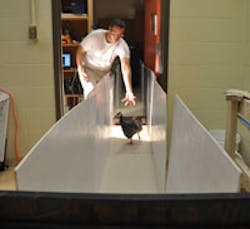Researchers: Walk Quickly, Don’t Shuffle, on Slippery Surfaces
Biomechanics researchers Timothy Higham of Clemson University and Andrew Clark of the College of Charleston said that approaching a slippery surface slowly hinders the necessary task of shifting the center of mass forward once foot contact is made.
The researchers studied helmeted guinea fowl strutting along a 6-meter runway that either had a rough-surface section (150-grit sandpaper) or a slippery one (polypropylene shelf liner). Helmeted guinea fowl react to slips much in the same way humans do, making them good test subjects, Higham said. High-speed video recorded the action.
“The findings can be useful in helping humans, especially older ones, make their way across surfaces that are wet, icy or oily,” said Higham. “The key to avoiding slips seems to be speed and keeping the body mass forward, slightly ahead of the ankles after the foot contacts the ground.”
Slips are a major cause of falls that can cause injuries and even deaths. Slips accounted for about 44 percent of fatal and nonfatal work-related falls, according to a U.S. Bureau of Labor Statics report in 1992.
Clark and Higham not only saw that speed, foot position and body alignment made a difference, but also the slip distance. For a guinea fowl to fall, it needed to slip a minimum of 10 centimeters – just under 4 inches. The distance is the same for humans, said Higham.
Guinea fowl leg joints and human knees and ankles function in similar ways. The position of the knee relative to the foot can create joint angles – wide or narrow – that can cause or prevent loss of balance on slippery surfaces, the scientists said. Once the knee passes the ankle during contact with slippery ground, slipping stops.
“Our study shows that there are common limb-control strategies on slippery surfaces in helmeted guineas and humans,” Higham explained.
The experiment is reported in the Journal of Experimental Biology.
About the Author

Laura Walter
Laura Walter was formerly senior editor of EHS Today. She is a subject matter expert in EHS compliance and government issues and has covered a variety of topics relating to occupational safety and health. Her writing has earned awards from the American Society of Business Publication Editors (ASBPE), the Trade Association Business Publications International (TABPI) and APEX Awards for Publication Excellence. Her debut novel, Body of Stars (Dutton) was published in 2021.
